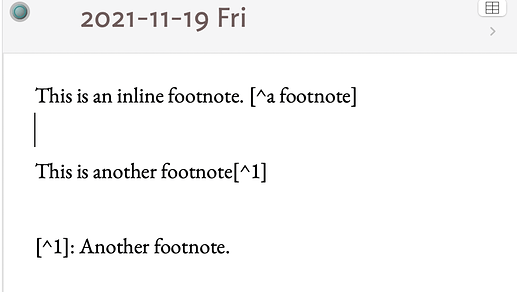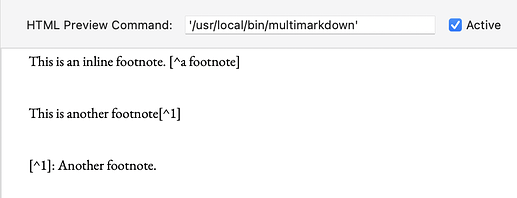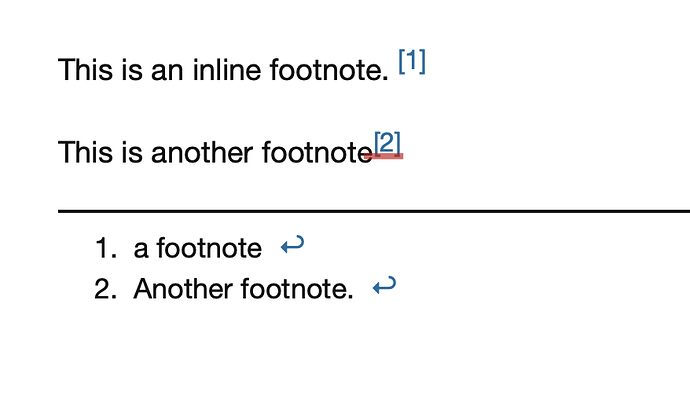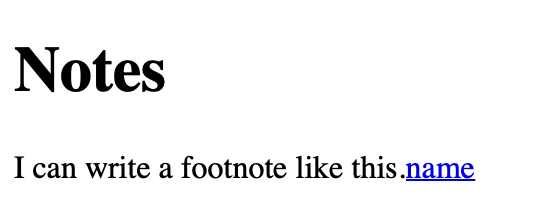I’d like advice on how to proceed, as I’m half way through a problem.
The Goal: Write a book in Tinderbox, with footnotes that are written using the MultiMarkDown (MMD) format. My goal is to be able to move things to Word at the last step, as I prepare for submission to a publisher. I’m an academic. Word files are where it is at.
The Example: Simply put, I want to do is write a MMD footnote in my Tinderbox note.
**The format**: This is some text that I would like to be able to write in MultiMarkDown[^footnote1]
[^footnote1]: MultiMarkDown is a format from Flecher Penny.
When I do this in a text file directly, things render perfectly in Marked 2.
Yet, doing this in a Tinderbox note, rendering in Marked 2, it never seems to work as I expect. Instead, it produces the following.
After many years of being stuck at this point, this morning, I realized that what seems to be going on is that there is a collision between the ^export^ syntax of TinderBox and the caret symbol of the MultiMarkDown footnote.
My first thought was backslash the caret. \^ But that didn’t work. So, my first question. Is there a way to force the caret not to be interpreted as a caret by Tinderbox?
Fiddling around, I found a work around, and created a Tinderbox macro, that simply adds a [^
This means that the following text
** The format ** : This is some text that I would like to be able to write in MultiMarkDown ^do("fn")^footnote1]
^do("fn")^footnote1]: MultiMarkDown is a format from Flecher Penny.
renders perfectly, in Marked 2’s stream preview and even directly in Tinderbox!
As an aside, to get it to work directly in TinderBox, I installed MultiMarkDown from Flecher Penny’s site, then changed the HTML Preview Command to “/usr/local/bin/mmd” for the note. It’s is MMD bliss! So, far. I’m flying.
My question are threefold:
-
First, as a straightforward goal. Is there a way to write [^fn_1] and have it render in MMD correctly? Or, are Macros the way to go? Can I backslash a caret? Or, in some other way, make this happen?
-
Second, the macro I came up with feels like a hack, and is hard to read as a human in my text. Is there a better way to use such a macro? However, when I try to use a macro like:
[^$1: $2]
Tinderbox adds space after the caret, and I can’t get it to render properly in MMMD becuase the macro seems to produce:
[^ footnote1]: MultiMarkDown is a format from Flecher Penny.
- Third, and my main question, is there a way I should approach doing this more dynamically and automatically? What I’d like is to a creates links of type note in the text, and then have Tinderbox look up the note, intert its $Text directly into the note ready for reading by MMD.
In other words, do some HTML Export Template magic, so that this
Becomes
**The format**: This is some text that I would like to be able to write in MultiMarkDown[^footnote1]
[^footnote1]: MultiMarkDown is a format from Flecher Penny.
Which can then get passed to MMD, and be rendered in a Preview pane and in Marked 2,* and crucially so that I can export to word at a later date.*
I am insistent on using MMD for footnotes, because it is trivial to use pandoc to convert a mmd file into a LibreOffice file which is then trivial to important into Word, all while keeping the footnotes!
Why do I care?: I wrote my first book in Tinderbox. But, when I moved from Tinderbox to Scrivener or to Word, I had to recreate footnotes by hand. I’d like a better way of doing them, as I start a new book, that will become 200 pages. The publisher wants a simple word file, no formatting, but with footnotes.
What I’d like to be able to write, create footnotes in tinderbox on the fly, then have a pathway to get everything into Word. MMD seems the best way to go. But, maybe it’s a red herring?
Ideas on how best to work with footnotes. Crucially, I think, is there a way to change the anchor text of a link programmatically as the text is exported? If so, as a note is exported, the link anchor text could be converted into a MMD footnote? But, I’m stuck on how to even approach that.
Basically, I’m looking for ideas on which direction to proceed.
Best
Daniel



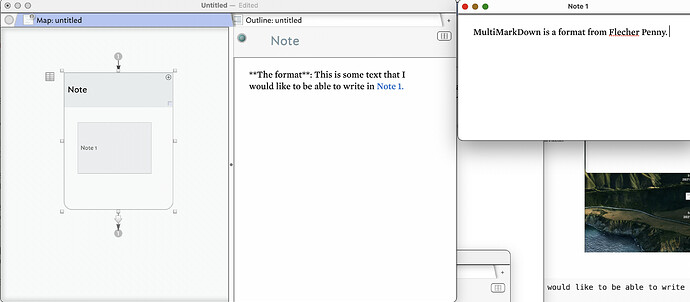

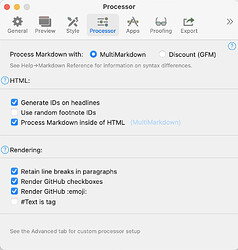
 How are ^ caret characters treated in a note’s text. As I troubleshoot, I wonder if TB be eating the ^'s, thinking they’re export codes.
How are ^ caret characters treated in a note’s text. As I troubleshoot, I wonder if TB be eating the ^'s, thinking they’re export codes.